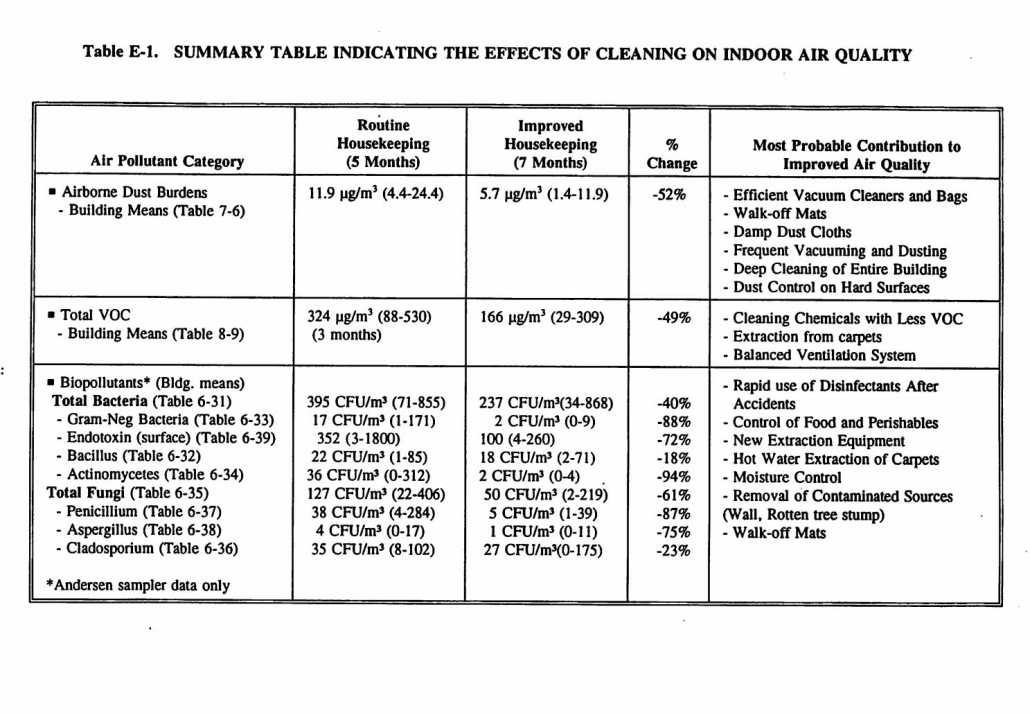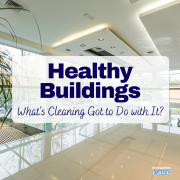Healthy Buildings: What’s Cleaning Got to Do with It?
Fact: You will likely take more than 6.6 million breaths inside of a building this year.
So whether that’s at home or work, the home improvement store or gym, the way these indoor environments are maintained will have a major impact on not only your health but also your performance. And now, in the wake of COVID-19, that matters more than ever.
If you’re a professional who has heard us evangelize the cleaning for health message, you know this well. From the Frank Porter Graham study to the Charles Young study, we’ve seen ongoing research the show the benefits of how a cleaning plays a role on the indoor environment, and in these instances, the health and performance of students in schools.
A quick glimpse at this summary shows the critical role that cleaning (specifically, cleaning frequencies) has on indoor air quality.

Though we’ve been talking about a health and evidence-based approach to cleaning for years, this holistic view of building wellness is starting to go mainstream. A slow drip at the start of 2020, this movement is now evolving into a full blown waterfall as organizations look to best navigate their way through the pandemic.
In the recently published book Healthy Buildings, Harvard researchers Joseph Allen and John Macomber take a deep dive into the how’s and why’s of healthy buildings. Written largely for a general business audience, the book makes a financial case for why organizations should invest in healthy buildings. From recruiting better employees to increasing productivity within the building to improving bottom line profits, authors cite both the trends and financial gains of focusing on “healthy buildings.”
When it comes to practice, they outline nine foundations of a healthy building, including: ventilation, air quality, thermal health, moisture, dust and pests, safety and security, water quality, noise and lighting and views.
You’ll find some common strategies for improving indoor air quality (source reduction) and dust (use HEPA filters) but the outline is loose. You might liken it to someone telling you all the reasons for making a cake, but providing very little instruction on how to make it. The way building is cleaned and maintained plays a significant role in the health and lifespan of a building.
Changes Ahead
This pandemic will force substantial changes on the way we use and clean buildings. Even though we’re just in the early stages of states reopening, we’re already starting to see changes in work from home policies. Some of these changes will be temporary, and others will have lasting impacts.
One thing that won’t change is the need to clean and maintain buildings. If anything, the pandemic has brought this reality to the center stage. But as awareness for healthy buildings grows, so will the “experts” who share best practices for maintaining those environments.
In a recent letter to the editor published in the Detroit Free Press, Pamela Owens-Moore, a mother and grandmother, who has worked as a janitor in Detroit for 33 years, made a plea for organizations to head input from janitors as they develop policies and procedures around cleaning and sanitation as businesses reopen.
“Not only will janitors be the ones responsible for adhering to stricter cleaning and safety standards,” said Owens-Moore, “but we have expertise and ideas to contribute when new protocols are being developed and decided on.”
As we move toward a society that values healthy buildings, make sure that your custodial team has a seat at the table when policies and procedures are developed. It’s great to create lofty goals, but the people who actually do the work, custodial workers, will be able to help your organization achieve those goals.
Cleaning is a key component to maintaining healthy, high-performing buildings. And when custodial teams have a stake in the strategy, everyone will be able to breath a little easier.


